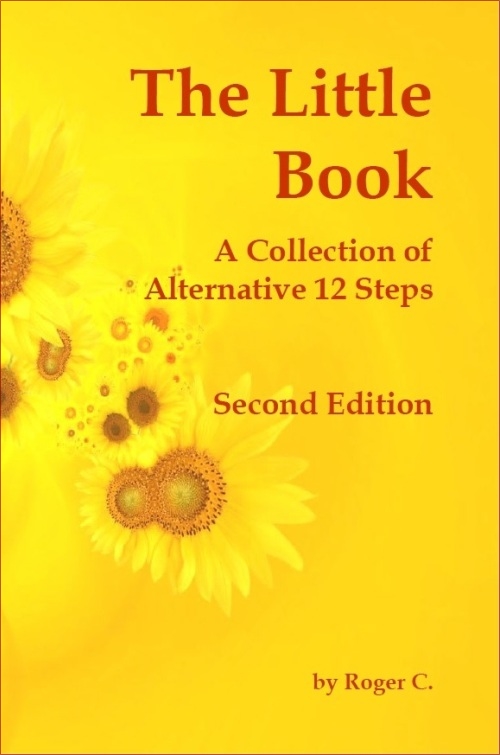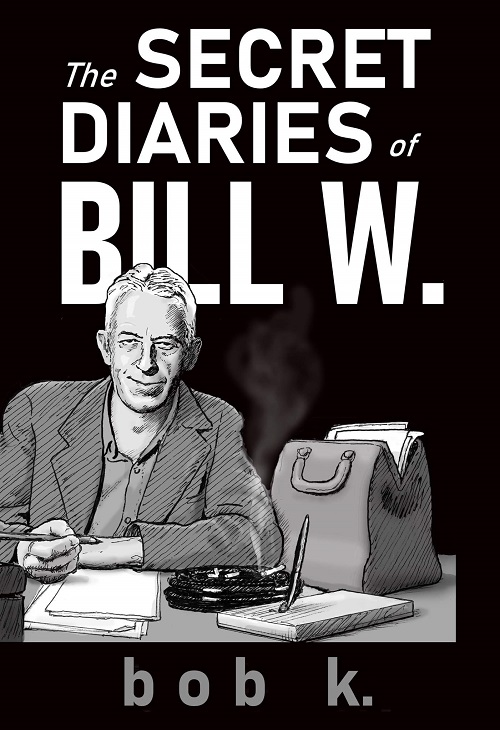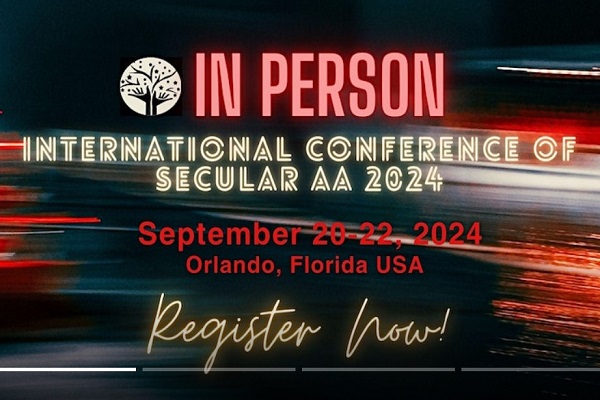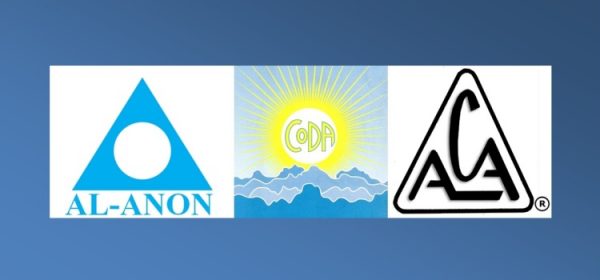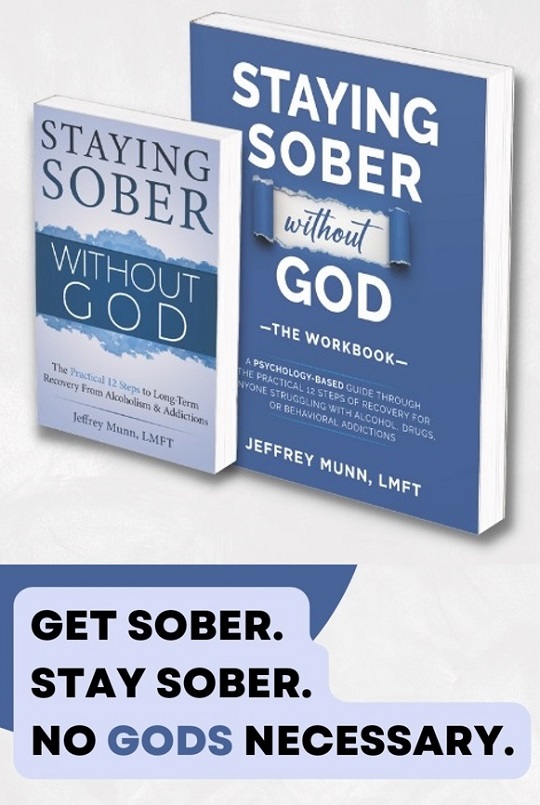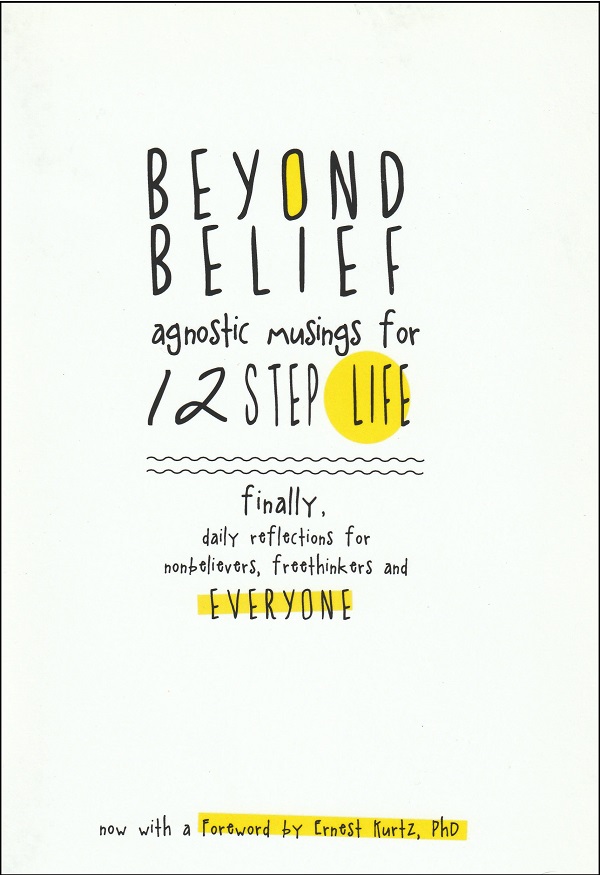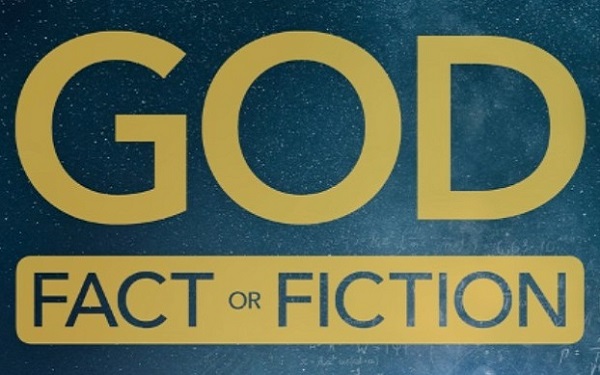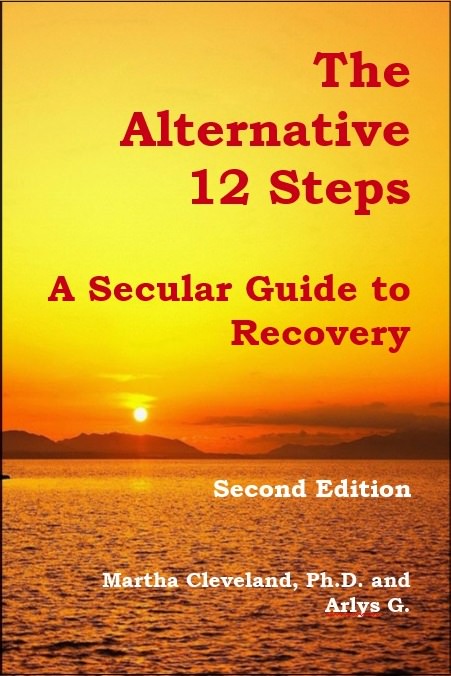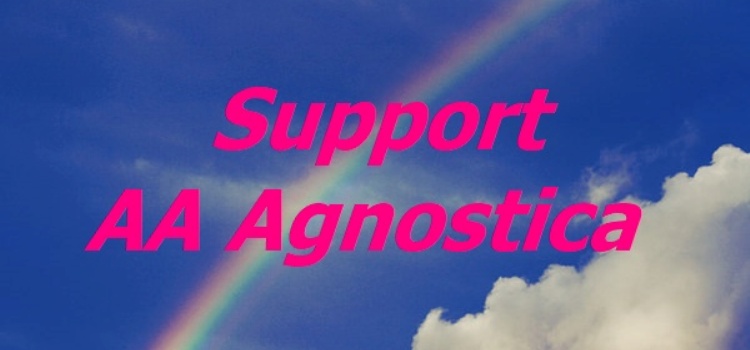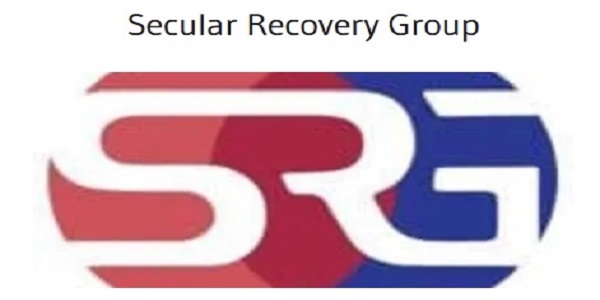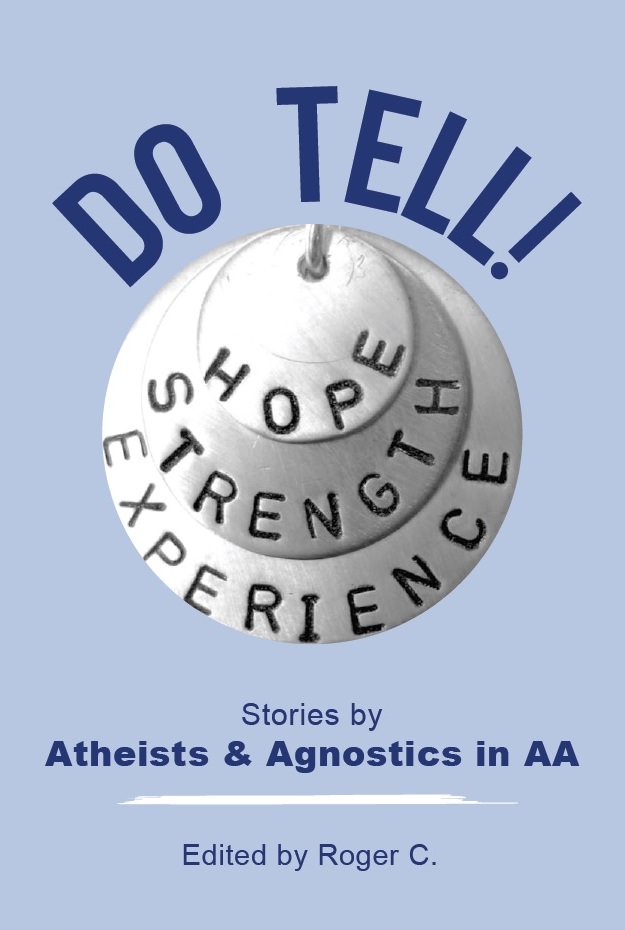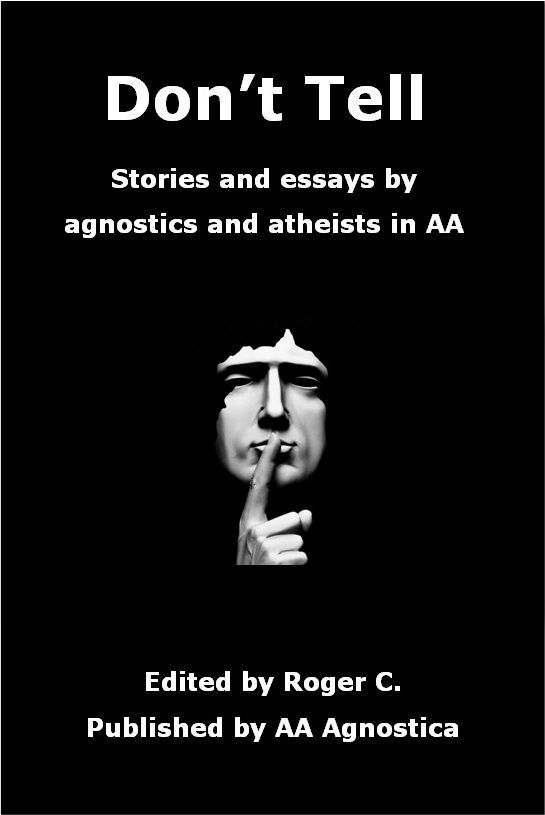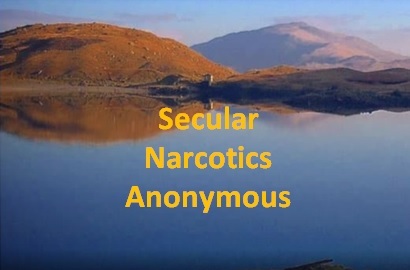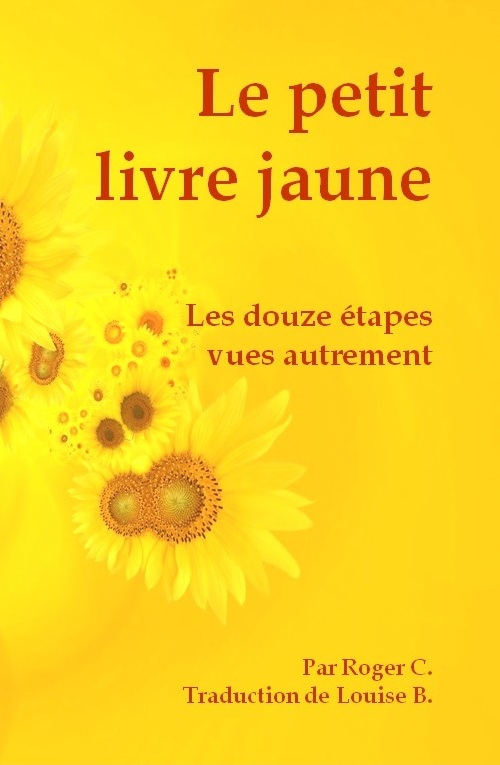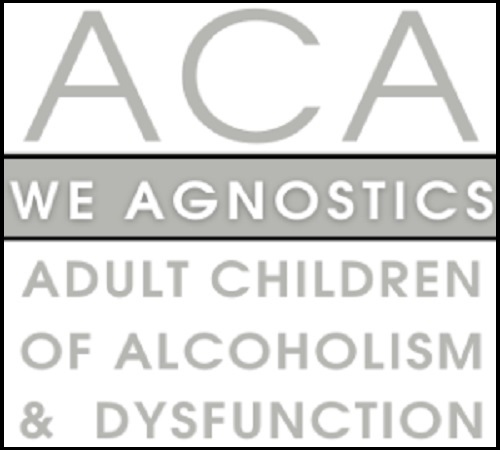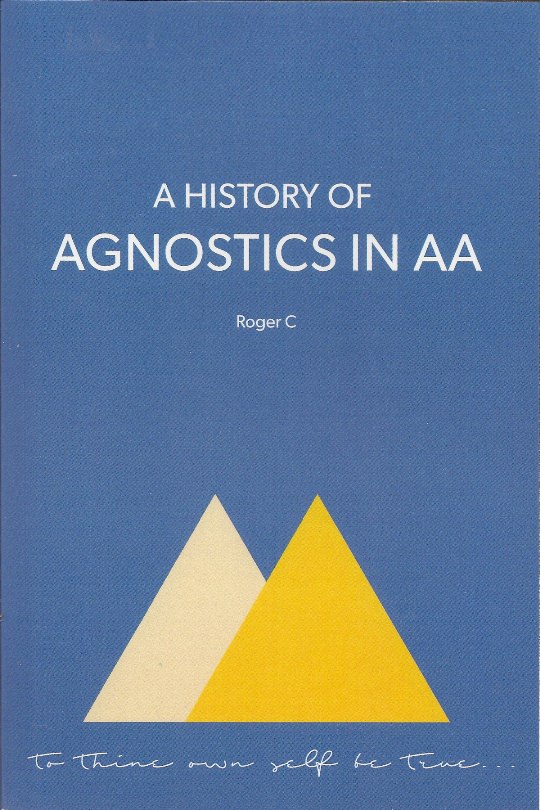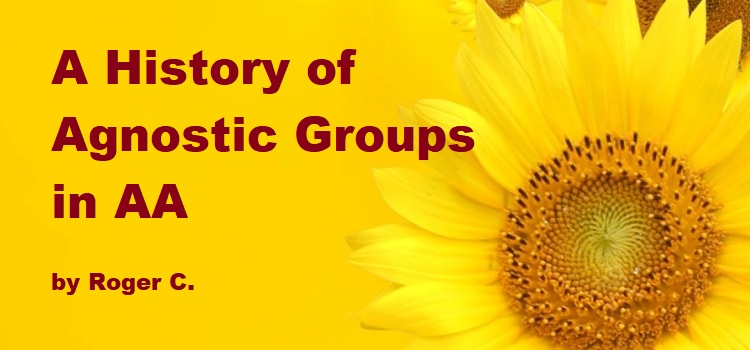 A magnificent work – clear, concise, respectful, insightful. I appreciate your work, and I am sure many others will. I also hope, with you, that this information will help atheists and agnostics in other, smaller places to be able to find comfort in AA… The fellowship owes you a debt of gratitude, though it may take time for them to realize that.
A magnificent work – clear, concise, respectful, insightful. I appreciate your work, and I am sure many others will. I also hope, with you, that this information will help atheists and agnostics in other, smaller places to be able to find comfort in AA… The fellowship owes you a debt of gratitude, though it may take time for them to realize that.
Ernie Kurtz, author of Not-God: A History of Alcoholics Anonymous and co-author of The Spirituality of Imperfection.
Final update August 20, 2012
by Roger C
Excommunicated
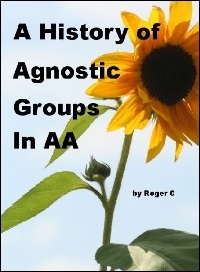 Two relatively new agnostic groups – We Agnostics and Beyond Belief – were kicked out of the official list of AA group meetings in the Greater Toronto Area (GTA) on May 31, 2011.
Two relatively new agnostic groups – We Agnostics and Beyond Belief – were kicked out of the official list of AA group meetings in the Greater Toronto Area (GTA) on May 31, 2011.
Three days later, the story made the very top of the front page of Canada’s largest daily newspaper, the Toronto Star, and this was the title: Does Religion Belong at AA? Fight over ‘God’ splits Toronto AA groups.
The GTA Intergroup passed a motion at its regular monthly meeting that the two groups “be removed from the meeting books directory, the GTA AA website, and the list of meetings given over the phone by Intergroup to newcomers.” The motion passed 24 to 15 with 9 abstentions.
Beyond Belief had been around for more than a year and a half. Twelve people attended its first meeting on September 24, 2009. We Agnostics had its first meeting almost a year later, on September 7, 2010. And both meetings were growing. To give more people an opportunity to share, Beyond Belief had added another room to its Thursday meeting. And it had recently added a closed weekly meeting on Saturdays.
The action taken by the GTA Intergroup was extreme. But there has always been tension between agnostics and the Christian members of Alcoholics Anonymous. What happened at the Intergroup meeting in that church basement in Toronto merely exposed a long-festering wound in AA.
Bill and Jim
The “God” part in the 12 Steps comes from Bill Wilson. The rest of it, “as we understood Him,” was Jim Burwell’s contribution.
But let’s start at the beginning…
AA’s soon-to-be co-founders met on May 12, 1935 (Mother’s Day), with Bill trying to help Dr. Bob sober up at Dr. Bob’s home in Akron, Ohio. Wilson worked away at that for almost a month: it would be the first recorded instance of one drunk helping another. Dr. Bob took his last drink on June 10, 1935 (a beer to steady his hand for surgery), and this is generally accepted as the founding date of AA.
In January of 1938, Jim Burwell joined the fellowship. AA consisted of two groups: one in Akron and the other one in New York. The latter group held one meeting a week, at Bill’s home in Brooklyn, which was attended by six or eight men. Only three men in that group, including Bill, had been sober more than a year. AA was a fledgling organization, to say the least.
Bill and Bob were both members of a Christian revivalist movement, the Oxford Group. “The early meetings were quite religious, in both New York and Akron. There was always a Bible on hand, and the concept of God was all biblical,” Jim reported.
Into that mix came Jim, “their self-proclaimed atheist, completely against all religion.”
Jim presented quite a challenge to the group, as he later wrote in Sober for Thirty Years. “I started fighting nearly all the things Bill and the others stood for, especially religion, the ‘God bit.’ But I did want to stay sober, and I did love the understanding Fellowship.”
At one point, his group held a prayer meeting to decide what to do with him. “The consensus seems to have been that they hoped I would either leave town or get drunk.”
At around this time Bill finished Chapter Five of a book about the fellowship. This chapter included the all-important 12 Steps, AA’s program of recovery.
It sparked a lengthy and heated debate about some of the wording of what was to become known as the “Big Book,” and especially of the 12 Steps.
There were two camps in the fellowship. One was a pro-religion camp that felt the book should incorporate the teachings of the church.
At the other end of the spectrum were a few atheistic and agnostic members, including Jim.
In Bill’s original draft of the Steps, the word “God” appeared six times. In the final version, Alcoholics Anonymous: The Story of How More Than One Hundred Men Have Recovered from Alcoholism (the name of the 1939 edition), the number of specific references to God was reduced to four, and in two of the Steps, courtesy of an insistent Jim B, “God” was qualified with “as we understood Him.”
It was the best compromise that could be achieved by those men in that epoch.
Twenty years later, Bill would look back and acknowledge that his early Christian evangelicism had been a serious problem. In an article in the AA Grapevine in 1961, The Dilemma of No Faith, he makes a startling admission:
In AA’s first years I all but ruined the whole undertaking… God as I understood Him had to be for everybody. Sometimes my aggression was subtle and sometimes it was crude. But either way it was damaging – perhaps fatally so – to numbers of non-believers.
Bill would also say that the atheists and agnostics of the day “had widened our gateway so that all who suffer might pass through, regardless of their belief or lack of belief.” (Italics in the original.)
But was the gateway widened enough? Looking back 75 years after the humble beginnings of Alcoholics Anonymous, the question has to be asked. Many of the nonbelievers in this century are not at all comfortable with the language of the Big Book or of the 12 Steps, language which pre-dates World War II.
And so it is asked, today: What about the “God bit”?
Jim Burwell went on to start AA groups in Philadelphia, Baltimore, and San Diego. Among the first ten members of the fellowship on the East Coast, he is often considered the third founder of AA. Jim is the first agnostic AA member to die sober: His sobriety date was June 15, 1938, and he died on September 8, 1974.
New York City
The very first agnostic group in New York City was called ‘We Atheists’ and its first meeting was held on September 10, 1986.
The group had three founders. They were Ada H, David L and John Y. How they came together to do this is a remarkable story, all on its own.
The three – all unknown to each other – answered an ad in the spring 1986 issue of Free Inquiry, a secular humanist magazine which, to this day, is circulated across America. The ad was from Harry, a Californian, and was addressed to atheists and agnostic members of AA who were having trouble with the religious nature of most meetings.
Over the next several weeks, Harry wrote to the three Easterners and provided encouragement and reassurance that they were not alone as agnostics trying to work the AA program to the best of their ability. He told them how it worked in Los Angeles and sent them a copy of the materials read at the agnostic group meeting he was involved with, We Agnostics of Pasadena.
Ada made the necessary arrangements with AA offices in New York and offered her apartment, on the upper east side of Manhattan, as a meeting site.
Ada was a very passionate woman, a socialist and a very wealthy New Yorker (her foundation continues to give to charities across the U.S.). She put together a meeting script, which is still used by the group today. It contains an extensive excerpt from Dr Bob’s last talk, delivered at the First International AA Conference on July 30th, 1950, in Cleveland. In Ada’s script, the meetings end with the group standing in a circle, holding hands, and chanting: “Live and let live.”
Regular meetings of the We Agnostics of New York City AA group were soon in full swing with John Y and David L in attendance. Later the ever-growing group moved to its present location at the Jan Hus Church, where it still meets. The church found the word “Atheist” a bit harsh, and so the name of the group was changed to “We Humanists.”
Much of the history in the preceding paragraphs is excerpted from Sampler, the group’s 1989 newsletter. The article was called, “Now It Can Be Told: A Bi-Coastal Tale of Two Cities.”
Ada H died in August, 2005, at the age of 83. She had more than 30 years of sobriety. Joan F, who is currently a member of We Humanists of New York City and will have 27 years of sobriety this November, visited Ada’s grave site recently over the summer. She reports that, at Ada’s request, her tombstone states that she started an Alcoholics Anonymous meeting for Atheists and Agnostics.
John Y died on March 10, 2003. He was a co-founder of the Secular Humanist Society of New York City, a life-long resident of the Bronx and a veteran of World War II. Born in 1921, he got sober in 1962.
He was the kind of guy who makes a point of shaking hands with everyone in the room prior to an AA meeting. In November, 2002, John celebrated his 40th anniversary of sobriety and told those present, “I never said a prayer in my life.”
David L, now in Pittsburgh, is still a regular in the rooms of AA. He is 74 and got sober in 1980. He remembers as a child trying to figure out what people meant when they talked about God. “It didn’t make any sense to me and I just couldn’t do it. That lasted the rest of my life, pretty much.” He said that when he got to AA, he had to “hang on to everything else,” except the God part, to make it work.
Chicago
It all began, ironically enough, in a church, the Unitarian Universalist Church.
Don W was a member and had been for a number of years. He had first joined the Unitarian Church in his mid-teens, in his home town of Omaha, Nebraska. “I joined this church free of dogma or creed, and have ever since shared in the music-making and the Sunday services of one or another Unitarian-Universalist congregation.”
He was also an alcoholic and a member of AA.
It hadn’t always been easy for Don. In the early sixties he had tried AA and had attended meetings for six months but left, put off by all the religiosity. “I was unable to work it, because of the religious language in which the 12 steps are couched,” he said.
He came back a decade later. His drinking had almost killed him. This time he decided he had to tough it out, no matter how hard.
After about four years of sobriety, in the autumn of 1974, he gave a talk at the Second Unitarian Church on Barry Street on the topic, “An Agnostic in AA: How it Works for Me.”
The talk was well received by the congregation, and he ended up delivering it in several Unitarian churches. In fact, one of the ministers encouraged him to start an AA meeting especially for atheists and agnostics.
The first ever meeting in AA explicitly for nonbelievers was held on January 7, 1975.
In Chicago. In a church.
And thus was born Quad A: Alcoholics Anonymous for Atheists and Agnostics (AAAA).
As Don explained in an article in the Chicago Tribune in 1995:
The first two As, for Alcoholics Anonymous, are far more important than the last two in AAAA, because a 12-step program will work for anybody who works it, regardless of religious belief, understanding or refusal to understand.
The Tribune article, headlined “A Different Road: Quad A Offers Help to Alcoholics Who Don’t Buy Into God,” was published on February 22, 1995 and was written by Lawrence Rand.
Don not only founded the group in Chicago, but he also played a role in starting the Quad A groups in Evanston and Oak Park.
John F talks about his involvement in the Oak Park group, which held its first meeting in 1990:
When I got involved in Quad A in Oak Park in ‘96 we used to have five or six people max at our Sunday meeting. But since about 2000 we have seen a steady increase, so that we regularly have 20 or 22 people, and we sometimes max out at 30 or thereabouts. This shows a steady increase in members over time. Accordingly, our sobriety is growing as well. People who got sober with us have mostly stayed with us. We’ve recently had four people celebrate 19 to 30 years of sobriety (some of it begun before they attended Quad A), two celebrated 15 years, while several members are now approaching 10 years, not to mention the substantial number of those who have between one day and three or four years of sobriety.
It’s the kind of story one would expect from any AA group.
In its literature Quad A happily quotes the Big Book: “To us, the Realm of the Spirit is broad, roomy, all inclusive; never exclusive or forbidding to those who earnestly seek.”
More than 30 years after Don W had founded the first ever AA meeting for nonbelievers, a Quad A Unity Conference was held on September 13, 2009, in Chicago. More than a hundred people attended. By their very presence, they were able to “bear witness to the reality that there are hundreds of atheists and agnostics who are working the program and staying sober,” Chuck K, principal organizer of the event, told those in attendance in his welcoming remarks.
The keynote address was delivered by Lisa D, and it was called, “How a Humanist Works the AA Program.”
Lisa described how she had come to understand that human values – “empathy, compassion, integrity, mindfulness, honesty, open-mindedness, diligence, excellence, serenity, courage, wisdom, and of course intimacy” – were the “greater power” to which she must strive to align herself.
Her talk was about how she worked the 12 Steps. Humanists, atheists, agnostics, secularists work the 12 Steps and, like everybody else following the suggested AA program of recovery, each does it according to his or her belief or lack of belief.
Especially lately, a plethora of resources have become available to those in AA of a non-Christian persuasion.
This includes, for example, the following three books: Darren Littlejohn’s The 12-Step Buddhist, Phillip Z’s work A Skeptic’s Guide to the Twelve Steps and Marya Hornbacher very recent book, Waiting: A Nonbeliever’s Higher Power.
Early in her talk, Lisa expresses her gratitude that “the very first meetings I ever attended were Quad A.” Otherwise, if she had heard the God bit in the early going she might have “run out the door screaming” and picked up again.
Don W wasn’t so lucky.
Having stumbled, having picked himself up, he started the first ever groups explicitly for agnostics and atheists.
He defined his agnosticism very simply: “I could never believe in a God small enough to fit inside my head.”
Don expired with the old millennium. Fittingly, a memorial service was held for him at the Second Unitarian Church.
Los Angeles, Austin and Beyond
“I am the daddy of all the ‘We Agnostics’ groups!”
The man who spoke those words, Charlie P, died on February 27, 2012, at the age of 98. They are ten words that no other human being could have ever uttered, which places them in a rather unique category.
And Charlie may indeed have at least partial ownership of the “We Agnostics” brand in Alcoholics Anonymous.
He co-founded the very first AA group ever to be called “We Agnostics,” in 1980 in Los Angeles. Of course the name “We Agnostics” is also a chapter in the Big Book.
The other co-founder, Megan D, was new to sobriety. She remembers starting the group with Charlie:
I got sober on Jan. 1, 1980. My first regular meeting took place immediately. I met Charlie about a month later. We spoke of our mutual atheism and he told me there were many of us in the program, but that we kept a low profile. About 3 months later he came to me and asked me to help him start a meeting for people like us. We were so cute trying to decide what to call ourselves. We finally decided to name our meeting after Chapter 4 of the Big Book.
At the time Charlie was 66 years old and had been sober in AA for nine years. “I was a nonbeliever and I felt that it was only fitting and proper to have a meeting which was friendly to nonbelievers.”
Shawn M describes “meeting hunting” in the Los Angeles AA directory when he came across the We Agnostics meeting and, curious, he decided to attend one of their meetings. He later wrote:
This was a group of people that did not subscribe to any notion of canned theology or cultish adherence to anything besides this: “no matter what” one does not put alcohol anywhere near the lips or nostrils. Also, if craving or life made you feel like jumping out of your skin, you must pick up the phone and talk with another meeting member. We help each other – “no matter what.” That was the guiding principle of the LA We Agnostics AA group.
At the end of the meeting, Charlie handed Shawn a piece of paper “that looked like one of the slips of paper from a fortune cookie” with the name “Charlie” on it along with a seven digit phone number.
This is what Charlie did. Over the course of more than four decades of sobriety, he had literally hundreds of sponsees. As his son put it, “He dedicated his life to helping others achieve sobriety, sponsoring hundreds to find a new way of living without alcohol.”
He became Shawn’s sponsor.
He was not an easy sponsor. Doing the Steps with Charlie was hardly a warm, pleasant experience. Brutal in fact. Much better than almost any shrink I had ever encountered and overwhelmingly wise. That was my first steps go around. Subsequent redoing of the Steps work proved simply enlightening with Charlie. It helped keep me sober then and still does now.
Charlie had had a tough life, which may in part explain why he was so devoted to helping others. His father had committed suicide when Charlie was 14 years old. His granddaughter, Angeliska, blamed this event for his alcoholism: “It was this tragedy that shaped who my grandfather would come to be: for half his life, an alcoholic who drowned his pain in drink, an actor, a collector of masks.”
But he found AA. Angeliska (Angel) continues:
There is no doubt that this program saved his life, and my grandparent’s marriage. Through AA my Grampa came through the tempest of his anger, his loss, and the void left by his father’s death, to become one of the most serene and wise sages I have ever known.
Charlie was a staunch atheist. “His heritage was Jewish but unlike many atheistic Jews, Charlie did not observe the holidays or traditions. That would have been a treasonous act to Charlie,” Shawn reports.
But he was a most spiritual man. Angel says: “My grandfather once told me that he was not a religious person, but that he was a spiritual person. I thank him for showing me, and many others, the freedom of that distinction.”
Constantly being called upon to explain in AA his understanding of a “higher power,” he eventually decided he could tolerate the notion that it was the “E” in “E=MC2”. It was “the total of all the energy in the universe,” according to his granddaughter.
Charlie moved to Austin in 2000 to be closer to his sons. On August 21, 2001 he achieved another first by launching the “We Agnostics” group of Austin,Texas.
Charlie started something in that city.
Shortly after that, on May 3, 2002, his good friend, Nick H, launched the Children of Chaos agnostic group. The group’s name is based on a line from the second paragraph of Tradition Four, in the Twelve and Twelve book: “Children of chaos, we have defiantly played with every brand of fire…”
Today, there are six meetings for agnostics, atheists and freethinkers in Austin.
Charlie died on February 27, 2012. He was 98 years old and had more than 41 years of continuous sobriety. Hearing of his death, Shawn wrote:
Charlie gave unselfishly and saved countless lives. He did not care to keep score. He was a very devoted loving husband, father, grandfather and great-great-grandfather. Charlie was significant contributor. He saved lives and reinstalled the ability to experience joy into many hearts. He was a holy man.
He remained active in the program until the very end, holding AA meetings at his bedside and receiving AA visitors up to the last week of his life.
Charlie was not the only founder of an agnostic AA group, although he certainly deserves credit and thanks for being the first among the first.
Today there are agnostic groups in AA in virtually every major city in North America.
The AA General Service Office lists 48 active agnostic groups in North America. But that’s hardly an official count: There is no requirement for an AA group to register with any organization, including the GSO.
The Agnostics AA NYC website lists approximately 87 groups in North America. That’s no doubt more accurate than the GSO list, but again nothing is guaranteed.
What is certain from a quick scan of AA groups over the years is that there is an explosion of these groups in recent years. Of the 48 agnostic groups listed as still active with the GSO, 30 of them – almost two thirds – held their first meetings after the millennium.
Des Moines
Let us not ignore the occasional group that isn’t even granted the opportunity to be booted off a regional list of AA meetings.
In Des Moines, Iowa, a We Agnostics group will celebrate its first anniversary on October 12, 2011.
Although the founders of the group registered it with the GSO, the Des Moines Intergroup has refused to include We Agnostics in the meeting list.
On a Facebook page, the dilemma of the group is described rather sadly and ironically: “Your application to the Outcasts Club has been denied.”
Don S and Tom H are the two founders of the group. Don – whose sobriety date goes back to June 14, 1991 – had 19 years of sobriety under his belt before he started We Agnostics. He was a traditional member of AA for ten years before he “completely lost faith.”
“Then, for about two years, I was nervous about my sobriety because of the God indoctrination I had received.”
In most cities in North America, and in virtually all towns and villages, AA meetings end with people standing, holding hands, and reciting the Lord’s Prayer.
Don ultimately decided he couldn’t – and shouldn’t – do that. He chose to remain seated during the closing prayer in order “to let others know that they are not alone and so that nonbelievers will feel welcome.”
And that approach has been very helpful.
Don met the other founder of We Agnostics at an “old school” AA meeting. He shared his lack of faith and Tom – who has 23 years of sobriety – talked about his own doubt. The two had a long conversation after the meeting. Don reported that “when I started the agnostic meeting, Tom was always there. He often opened up and made the coffee. We would not have met if we were silent about our unbelief.”
And Don met a sponsee in this way. “Now I sponsor one guy because he saw that I didn’t participate in the prayer. He was returning to AA and was wary because he was now an atheist. He has 90 days now and is tremendously relieved that there is a way to do AA without God.”
When Don originally asked for the group’s meetings to be listed on the Des Moines Intergroup meeting list, he was told that there was a six month waiting period. After six months he wrote and was told that the application was being referred to a committee.
Finally, in April, Intergroup sent Jayson J to monitor a meeting of We Agnostics. Don reports that the following exchange took place. Don told him that the group was registered with the GSO.
Jayson: “Well they’ll take anyone. There’s more to it than that.”
Don: “Then how can we meet your criteria?”
Jayson: “I don’t know.”
Missteps
In the rooms of AA, alcoholics are often told to interpret the “God” found in the 12 Steps any which way. It’s God “as you understand Him.”
This goes back to the original formulation of the Steps. As was mentioned earlier, there was a fierce debate over the wording of the Steps. In Not God: A History of Alcoholics Anonymous, Ernie Kurtz reports that Bill W “accepted the utility of compromise” and quotes him from Alcoholics Anonymous Comes of Age:
In Step Two we decided to describe God as a “Power greater than ourselves.” In Steps Three and Eleven we inserted the words “God as we understand Him.” From Step Seven we deleted the expression “on our knees.” And, as a lead-in sentence to all the steps we wrote these words: “Here are the steps we took which are suggested as a Program of Recovery.” A.A.’s Twelve Steps were to be suggestions only. (Italics in the original.)
The steps are suggestions.
It has ever been thus in AA. This is entirely consistent with the “attraction not promotion” of the 11th Tradition.
Generally, the nature of a suggestion is such that it can be ignored outright without dire consequences, let alone just adapted.
Those who don’t always follow suggestions – all of us – should hardly be subjected to expulsion, as there will be none left to close the door on the way out.
As for the “Higher Power:” By and large, agnostic, atheist and humanist members of AA have no more difficulty than anyone else understanding that they are powerless over alcohol (Step 1) and must turn their lives over to resources or forces more powerful than themselves (Steps 2 and 3). In one of his books, cultural anthropologist Ernest Becker wrote:
We always rely on something that transcends us, some system of ideas and powers in which we are embedded and which support us. This power is not always obvious. It need not be overtly a god…It can be the power of an all-absorbing activity, a passion, a dedication to a game, a way of life…
The difference for an agnostic is that this “higher power” is most often a secular one, or simply unknown, too big to fit in a head.
Since the beginning of AA there have been non-theistic versions of the 12 Steps of recovery. Of necessity, for people like Jim Burwell. Of necessity, for the agnostics, atheists and humanist alcoholics in the rooms of AA.
This with the blessing of the co-founder of AA so that all who suffer – “regardless of belief or lack of belief” – can pass through the doors of AA.
However, the mortal sin of Beyond Belief, at least in the eyes of some in the GTA Intergroup, was to have a written secular version of the 12 Steps.
There will be “literalists” in AA. Bill W acknowledged this problem. In a letter in 1961, he wrote:
As time passes our book literature has a tendency to get more and more frozen – a tendency for conversion into something like dogma. This is a trait of human nature which I am afraid we can do little about.
What the adapted version does, perhaps not surprisingly, is remove words that typically create a great deal of discomfort for agnostics: “God,” a higher power referred to as “Him,” and a reference to a “Power” that, in the context, is supernatural.
That’s it. Otherwise the 12 Steps are identical; it’s the “God bit” that has been removed.
Nor are these Steps a creation of the Beyond Belief group: this version has been available online since the first days of the Internet.
That there are a myriad of interpretations of “God as we understood Him” is both laudable and inevitable. Laudable because it has enabled any number of nonbelievers in AA to live a life of sobriety. Inevitable given that “any alcoholic is a member of our Society when he says so” (Tradition Four) and that word “any” covers a lot of territory.
In fact, AA is notorious for inviting the suffering alcoholic to interpret God quite liberally. For some, God can be Good Orderly Direction. For others it’s the fellowship of recovering alcoholics or the program of recovery itself.
All of which left some members of Beyond Belief perplexed. “They told us to interpret God any way we wanted and we did exactly what we were told,” Katherine, a young woman with several months of sobriety said.
“And then they kicked us out.”
Misdeeds
Beyond Belief was not, however, the first agnostic group to be delisted by an area Intergroup.
That dubious honour goes to the Indianapolis We Agnostics group. Founded on November 1, 2009, by Joe S, Heather B and Chris W, the group is the first and only agnostic group in Indiana.
And it wasn’t just booted out once, but twice.
In a letter dated November 3, 2010, coincidentally on the group’s first anniversary, signed by both the Indianapolis Intergroup office manager and the chairman, the members of We Agnostics were told that “your group reads a changed version of the Twelve Steps” and “It is the judgement of the Indianapolis Intergroup’s Service Committee that your group has decided it is not an A.A. group.”
It was quite a surprise to the group that they had made such a decision.
The authors of the letter go on to explain the reason for their de-listing. “Early in the Big Book our founders made it clear that we alcoholics suffer from a disease which only a spiritual experience can conquer.”
Several group members met with the Indy Intergroup and We Agnostics was re-listed. They agreed that an adapted version of the 12 Steps would not be read at their meetings. In fact the We Agnostics “group conscience” was that literature that was not GSO-approved would not be included in the meeting format.
Nevertheless, the group was officially booted out for a second time on May 8, 2011. This time no reason was given. Group members were not contacted. They were not told in advance that the issue was on the Intergroup agenda. They were not told of the allegations against them. They were not provided with an opportunity to offer any kind of defence. They were not even informed of the decision by Intergroup to de-list them but learned of it afterwards from a third party, accidentally.
It was kind of a hit and run incident.
An article in the July issue of the Indianapolis Intergroup, Inc. newsletter, The Paper, boasted that “Indy AA remains undiluted” as a consequence of the expulsion of We Agnostics.
“Nothing in the committee’s decision in any way attempts to exclude or limit ANYONE from AA membership, so long as he/she has the requisite desire to stop drinking” the article goes on to say, suggesting that it’s not acceptable to exclude an individual but it’s okay to boot groups of nonbelievers – such as We Agnostics – out of AA.
One nonbeliever, no. Two or more, yes.
But is that true?
One of the co-founders of AA, Bill W, wrote this in the July, 1946, Grapevine:
So long as there is the slightest interest in sobriety, the most unmoral, the most anti-social, the most critical alcoholic may gather about him a few kindred spirits and announce to us that a new Alcoholics Anonymous Group has been formed. Anti-God, anti-medicine, anti-our Recovery Program, even anti-each other — these rampant individuals are still an A.A. Group if they think so! (Italics in the original.)
The Indy Intergroup clearly made an effort to present both sides of the debate around the de-listing of this group, or perhaps even any group. In the August issue of The Paper there is a lengthy article entitled, “The Other Side of the Story – Expelling a Local Group.” In that article Donna H takes great exception with the expulsion of We Agnostics: “Simply, the Service Committee has greatly over-reached its boundaries (they are trusted servants, they do not govern) and have completely ignored at least six of our Traditions.”
She goes on to say:
There was neither respect nor careful consideration; neither trust nor love. Personalities were everywhere and sadly not one Service Committee member asked themselves if there “might be another way to deal with this” or “maybe we should consult the traditions” or even “let’s decide not to decide tonight.” Instead there was a pound on the table, the decision made (not voted on mind you) and the meeting was ended.
In some detail she then explains how Intergroup’s actions violated six of the Traditions of AA.
The issue simmered and festered over the summer and into the fall.
And it did a lot of damage within the AA community in Indianapolis.
Virginia R, the AA area delegate for southern Indiana reported: “The committee’s action caused all sorts of collateral damage. Long-time friendships were affected and there was a general sense of simmering hostility from all corners of our local AA community.”
Faced with an unprecedented backlash, the Intergroup Service Committee met again on Thursday, October 6, and voted to re-list We Agnostics.
At this point, “it got very twisted,” according to Joe S, a founder of We Agnostics, as he described the process of re-listing his group.
The de facto lawyer for the Service Group and the author of the article “Indy AA remains undiluted” in the July issue of the Indianapolis Intergroup newsletter, Stephen U, argued on Saturday, October 8, that the vote to re-list We Agnostics was “null and void.”
Something to do with proper notice of the vote not having been provided.
A day later, on Sunday, October 9, a general membership meeting of the Indianapolis Intergroup was held.
At that meeting representatives of AA groups in Indianapolis expressed their lack of confidence in the Service Committee and voted (“something like 112-72,” according to Donna) against the decision to delist We Agnostics.
The following Thursday, October 13, the Service Committee met in a special meeting and voted, for a second time, to re-list We Agnostics.
Proper notice must have been provided this time, because the very next day – more than six months after having been delisted – We Agnostics was back on the meeting list on Intergroup’s website.
It was a gruelling experience for all involved.
Joe, who is the first to acknowledge that his own behaviour was not always impeccable, says that he is exhausted as a result of the controversy. “I have been detoxing from it for weeks,” he said.
The area delegate, Virginia, says, “The whole ordeal was physically, emotionally and mentally exhausting. Glad to be done with it.”
And the final outcome?
According to Joe, the Service Committee has now taken the position that “if anyone complains about a meeting, they will be told to go to another meeting.”
Nor is it just Intergroups that are taking shots at agnostic groups these days.
The General Service Office (GSO) in New York City has also gotten into the debate.
On September 28, 2010, Gayle S R, a GSO staffer, wrote to the administrator of the Agnostic AA NYC website. In the letter Gayle points out that the website refers to “addicts” as well as alcoholics – still a no-no in “old school” AA. Worse, the secular version of the 12 Steps was available on the website.
“So we respectfully request that your group stop calling itself an A.A. group,” Gayle concluded.
The “group” removed the modified 12 Steps, and any reference to addicts, from the website.
Meanwhile, back in Toronto…
It may be worth noting at this point that it’s often not easy being a nonbeliever in AA.
Even in the best of groups there can be a good deal of peer pressure, of intimidation. Those infected with the “God bit” are inclined to spread it. It appears to be the nature of religious conviction.
A conscious effort to accommodate nonbelievers is thus sometimes necessary.
And this is what happened in the Hill Group in Toronto.
Denis D reports that in the years before there were explicitly agnostic groups in AA, “the Hill Group on Monday nights split into several rooms: beginner room, step discussion room, woman only room, etc. One of the rooms became informally known as the ‘No God’ room. I was a Hill Member and a regular at the No God room.”
The “No God” room was a feature of the Hill Group from the late 1970s until the mid 1990s – almost two decades. And it had a lot of members, such as John R, Ray C, John F and Marlene C. Most have passed.
Denis D – who is a devout agnostic, and has been sober since February 1978 – is now a regular at Beyond Belief.
Things have changed, of course, since the time of the “No God” room in the Hill Group and the formal expulsion of Beyond Belief and We Agnostics at the end of May, 2012.
Some old-timers will tell you that AA was more open back then, more tolerant. Newcomers were accepted no matter what they believed, or didn’t believe. What someone believed wasn’t the point.
In some groups now, there is much more emphasis on a Higher Power, whom many choose to call “God,” and there is only one way recovery from alcoholism works, and that’s found in “How It Works” – pages 58 to 60 of the Big Book – which is read at the beginning of meetings. Of course, the newcomer might not understand all of this right away but she will “get it” in due course, if she doesn’t get drunk or die first. In the meantime, she is to remain silent; the group will brook no dissent. This kind of group always ends its meetings with the Lord’s Prayer.
All of which may help to explain the desire for agnostic groups.
It is perhaps important to note that the AA General Service Office (GSO) in New York played a role in the delisting of Beyond Belief and We Agnostics.
Asked if a group can adapt the Steps, a GSO staffer, Mary Clare L wrote: “If we are aware that an A.A. Group listed here at G.S.O. has in any way modified the A.A. Steps we do not list them.” This is from an email on April 4, 2011, and is reported in the July issue of the GTA Intergroup’s newsletter, Better Times.
But Mary Clare realized that she had made a mistake, and, to her credit, in a letter to the GSO area delegate, Robb W, on June 14, she wrote: “I need to correct a misstatement on the text that I sent you because my understanding of what happens here at G.S.O. was wrong.” She continued:
As embodied in the Fourth Tradition, the formation and operation of an A.A. Group resides within the group conscience of its members… Groups listed in the directory are listed at their own request… It is not any A.A. member or A.A. group’s right to stand in judgment of another.
Mary Clare offered to “make amends” by sending her correction to groups in the area.
And to the credit of the GTA Intergroup, Mary Clare’s correction is printed in an “apology” in the September issue of Better Times.
But the damage had already been done. The groups were out.
And they would stay out, although the issue of agnostic groups – and related concerns – would bounce around the GTA Intergroup meeting rooms for the next six months.
Two motions were heard at Intergroup;s holiday season meeting on December 20, 2011.
First, there was a motion to de-list another group.
In the six months since We Agnostics and Beyond Belief had been booted out, a third agnostic AA group had held its founding meeting in Toronto. The group’s name, Widening Our Gateway, was based on Bill W’s observation that atheists and agnostics “widened our gateway so that all who suffer might pass through, regardless of their belief or lack of belief.”
Agnostic AA groups were apparently on the upswing in Toronto in spite of the ban imposed by the GTA Intergroup.
Rumours about the group had been rampant. It was said that although the group read the traditional 12 Steps of AA at the beginning of its meeting, it also shared an interpretation of some of the steps without the “God” word.
Four self-appointed AA cops decided to investigate and showed up at a Widening Our Gateway meeting on a Sunday in late November and, sure enough, they concluded that there was evidence of tampered steps.
And so Dan H from the Trial and Error Group moved that “the Widening Our Gateway Group be suspended from any involvement at Toronto Intergroup.”
That motion would eventually be passed on April 24, 2012, by a vote of 27 to 17.
And, once again, the General Service Office (GSO) weighed in on the issue of agnostic groups in AA.
The Intergroup executive shared a letter from Robb Watson, the area AA delegate representing the GSO. Even though it might well be argued that it was Robb’s job to be aware of the viewpoints of all AA members in his region and represent those views at General Service Conferences, and even though Robb had repeatedly been invited to attend a meeting of either of Beyond Belief or We Agnostics, he had never bothered to do so, or in any other way become aware of the “experience, strength and hope” of these women and men, all duly recognized as members of AA by the organization for which he toiled, the General Service Office. Nevertheless, it was his opinion that agnostic groups should “not imply affiliation with Alcoholics Anonymous,” as they share an adapted version of the 12 steps.
We do not ask anyone to believe anything when they arrive at the doors of AA, he wrote. However. “It is hoped that people will ‘come to believe’ as I did through working the 12 Steps of A.A.”
Kind of reminds one of those sometimes belligerent members mentioned above, in groups that do readings of “How It Works” and end their meetings with the Lord’s Prayer.
Robb’s contribution led rather inevitably to the second motion at the end of the meeting. Why not plough forward, if even the GSO is on side, delegates surely must have thought.
The Port Credit Group moved that the GTA Intergroup Procedures and Guidelines be changed “to make it perfectly clear that an AA group needs to adopt the 12 Steps, 12 Traditions and 12 Concepts of AA.”
We pause this historical look at agnostic groups in AA, but only briefly.
Rather than move forward and tell you what happened to this motion, we will instead look backwards in time.
Imagine it is 1946. Bill W, co-founder of Alcoholics Anonymous, is reflecting on, actually, very similar concerns which arose in the first ten years of the existence of the fellowship. He writes:
The way our “worthy” alcoholics have sometimes tried to judge the “less worthy” is, as we look back on it, rather comical. Imagine if you can, one alcoholic judging another. At one time or another most A.A. groups go on rule-making benders… Gossips gossip and righteously denounce the local Wolves and Red Riding Hoods. Newcomers argue that they aren’t alcoholics at all, but keep coming around anyway…Others refuse to accept all the Twelve Steps of the recovery program. Some go still further, saying that the “God business” is bunk and quite unnecessary. Under these conditions our conservative program-abiding members get scared. These appalling conditions must be controlled, they think, else A.A. will surely go to rack and ruin… At this point the group enters the rule and regulation phase. Charters, bylaws and membership rules are excitedly passed and authority is granted committees to filter out undesirables and discipline the evildoers.
Bill gently chides the rule-makers and concludes with a principle of inclusivity that is sometimes elusive in AA, and not just in Toronto:
Our A.A. door stands wide open, (We) sign nothing, agree to nothing, and promise nothing. We demand nothing. (We) join on our own say-so… We do not wish to deny anyone the chance to recover from alcoholism.
Fast forward now, back to 2012, back to Toronto, and back to the GTA Integroup.
The motion that an AA group must “adopt the 12 Steps, 12 Traditions and 12 Concepts of AA” – as written – in order to be listed on the official AA meeting list and participate at Intergroup meetings was put to a so-called “referendum” and the results announced in June. The final tally was 832 for the Motion, and 286 against. (Out of the 330 groups in the GTA, 72 voted and the tally reflects the number of members in each group present for the business meetings in which the vote was held.)
Some time ago, Joe C, a founding member of one of the booted groups, Beyond Belief, commented on the debate around agnostic groups in AA.
“My bold prediction is that if AA doesn’t accommodate change and diversify, our 100th anniversary will be a fellowship of men and women with the same stature and relevance as the Mennonites; charming, harmless and irrelevant,” Joe said.
Before we talk more about Mennonites, however, let’s look at how a real religion (as opposed to the “spiritual kindergarten” of AA, as Bill W called it), the Catholic Church, dealt with a similar conflict half a century ago.
Vatican II
The Second Vatican convened in the mid-1960s, a time when the Catholic Church had within it some deep divisions.
While most Catholics just wanted to practise their faith, a group of biblical literalists took offense with those with a more contemporary interpretation of scripture and a somewhat more nuanced understanding of how salvation was to be achieved.
When Pope John XXIII opened the Vatican Council in 1962 his goal was to bring the Church into the modern world and to restore unity among all Catholics.
After three years of deliberations, on December 7, 1965, the delegates voted on a Declaration of Religious Freedom (Dignitatis Humanae). Typical of the declaration was this simple statement:
All men are to be immune from coercion on the part of individuals or of social groups and of any human power, in such wise that no one is to be forced to act in a manner contrary to his own beliefs, whether privately or publicly, whether alone or in association with others.
It passed by a vote of 1,997 to 224. The war among the groups within Catholicism was put to rest.
The situation in Alcoholics Anonymous is eerily similar to that faced by the Catholic Church prior to Vatican II.
If, in the second sentence of this section, the word “scripture” is replaced by “Big Book” and “salvation” by “sobriety,” the inner conflict in the two organisations is identical.
Alcoholics Anonymous is and must be a wonderfully diverse fellowship. As Marya Hornbacher, author of Waiting: A Nonbeliever’s Higher Power, put it in a recent blog:
I’ve become aware that 12-step programs are home to people from every religion, denomination, sect, cult, political tilt, gender identity, sexual preference, economic strata, racial and ethnic background, believers in gun rights and abortion rights and the right to home schooling, drinkers of coffee and tea, whiskey and mouthwash, people who sleep on their sides or their stomachs or sidewalks.
And, increasingly, a lot of agnostics, atheists, humanists, secularists and outright nonbelievers.
For example, in 1939, when the Big Book was first published, virtually all of the recovering Alcoholics in AA in New York City and Akron, Ohio, expected a religious ceremony when they died.
According to studies conducted by the American Religious Identification Survey (ARIS), the number of nonbelievers today has now reached 15 per cent in America, twice as many as twenty years ago.
Two thirds of these people don’t want or expect a religious service when they die.
Many of them are – or will become – alcoholics.
These men and women too will need a home in the rooms of AA. They must not be booted out, either one at a time or in groups.
The vast majority of the members of AA merely want to maintain their sobriety and be a part of a fellowship that helps other suffering alcoholics who reach out for help.
And that’s what AA is all about. The responsibility declaration, originally adopted by AA at the 1965 International Conference in Toronto, affirms:
I am responsible. When anyone, anywhere, reaches out for help, I want the hand of A.A. always to be there; and for that I am responsible.
However some have a more religiously tinged understanding of the role of the fellowship. For example, a shy German-American woman told the Quad A conference in Chicago in 2009, “People told me that if I didn’t get on my knees and pray to God, I would go out and drink again.”
A statement like that can be a game-ender for a nonbeliever seeking sobriety in AA.
It’s bad enough when one individual says it but when a group … or an Intergroup … promotes it, then there are the makings of a serious problem. At that point even those with the deepest faith, perhaps especially those with the deepest faith, know that something is terribly out of kilter and that neither AA’s Traditions nor the responsibility declaration are being respected.
Perhaps AA needs its own Vatican II.
It would not be without precedent.
There was a time when gays and lesbians did not feel welcome in AA. That changed in the seventies. In 1973 the question of gays being listed in the AA directory was raised and put off. A year later, after two days of heated debate, the 1974 General Service Conference voted 131 to 2 to list groups as gay in the AA directory.
While Vatican II had to write one from scratch, AA already has its own Declaration of Freedom. It’s the Third Tradition (long form):
Our membership ought to include all who suffer from alcoholism. Hence we may refuse none who wish to recover. Nor ought A.A. membership ever depend upon money or conformity. Any two or three alcoholics gathered together for sobriety may call themselves an A.A. Group, provided that, as a group, they have no other affiliation.
The festering wound revealed by the expulsion of agnostic groups in both Indianapolis and Toronto no longer can, or should, be ignored.
When Catholics met back in the 1960s, participants were prepared to listen to each other with openness and respect. A Bishop from Hong Kong described the famous “spirit” of the Second Vatican Council that led to its historic achievements: “Only dialogue and negotiation can solve conflicts.”
May the spirit of Vatican II prevail in Alcoholics Anonymous in the days ahead.
– The End –
To download a PDF of this article, click here: A History of Agnostic Groups in AA.


